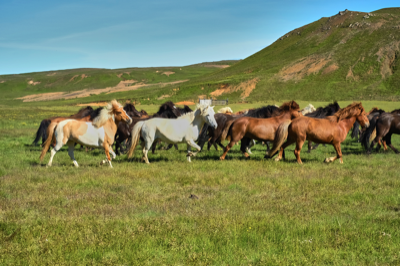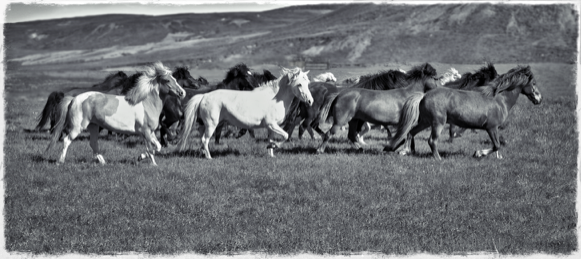(members only)


Most people would call the original image a grab-shot, perhaps a shot only meant as a memory tweaker. We had been looking for days to find a scene of Icelandic Horses on the run. We found lots of horses eating, many laying down, and some swatting flies. We would get out of the car, approach the horses, try some idle chit-chat; but, invariably I would be left with a lot of uninteresting shots. On our last day of driving around the country before returning to Reykjavik, we saw these horses running across the field. Well, when you jump out of a car to capture a moving herd of horses I guess you could say it was a grab-shot... but later I saw potential in the image and was able to create a photograph I'm proud to share.
When looking at an image, I use the LDW strategy and try to objectively determine what I like and dislike about the image. Only then can I decide what needs to be done to create the image in my mind and determine if my software and skills are up to the transformation tasks.
I often keep my camera on ISO 1600 and either f5.6 or f8 to ensure that I can freeze action with a decent depth of field when an opportunistic shot appears. Such was the case here. Oh yes, I had my 35mm f1.4 prime on the end of my Fuji X-Pro2. I tried hard to keep the two most interesting animals on the left in the frame as I focused and depressed the shutter... that was about all I could do! The camera clicked at 1/3500 second, and in a flash, the horses would be running away!
Back in the USA, I looked at the image on my monitor. Could I use this raw material to create the image I wanted? There was plenty to like about the image, but a lot of stuff to dislike and some of the things that needed to be done frankly looked challenging. But I did have some interesting software to work with... Capture One Pro and the MacPhun Creative Kit (particularly Snapheal CK) and these items would prove invaluable.
The Alan Skerker LDW Strategy for Creating Photographs: Likes, Dislikes, and What to Do About it?
The secret sauce is to look at your images objectively without falling into the self-denial trap that a particular distraction or error made in taking the image is okay because that was the way it was.
Likes:
The graceful motion of galloping Icelandic Horses
The distinctiveness and variations of the manes
The Pinto and White horses on the left have their heads partially turned towards the camera compared to the others
How I managed to get the horizon straight, I do not know, but I'll take it!
Dislikes:
Too much grass and sky.
The green and brown colors of the landscape compete with the earthen tones of the horses and the bland blue sky is simply awful
Too much depth of field. The background is too sharp.
Horses leave the frame on the right side. No space to run. Terrible composition as shot.
Horses take up too small a fraction of the frame due to the focal length of the lens and the aspect ratio of the sensor.
The nose of the Chestnut mare on the right is slightly soft
White fence gate sticks out of the white horse’s head... I guess I should have raced after the horses to get a better composition
What to do About it:
Go black and white to eliminate the color distractions
Remove the horses on the right side
Blur the background a bit
Brush in structure and sharpness on the Chestnut mare
Make the horses dominate the scene
Convey a feeling of ranching similar to the old west... remember the grandeur of watching westerns in living Cinemascope
I used Capture One to convert the image to black and white, and Snapheal CK to remove the horses, add some blur to the mountains, clean up some of the grassy areas and make the gate and fence-posts less obvious. I cropped the scene to a Cinemascope aspect ratio (2.35:1) and added the roughened border. Oh, don't tell anyone I started with an in-camera JPEG. Hi-Yo Silver!


